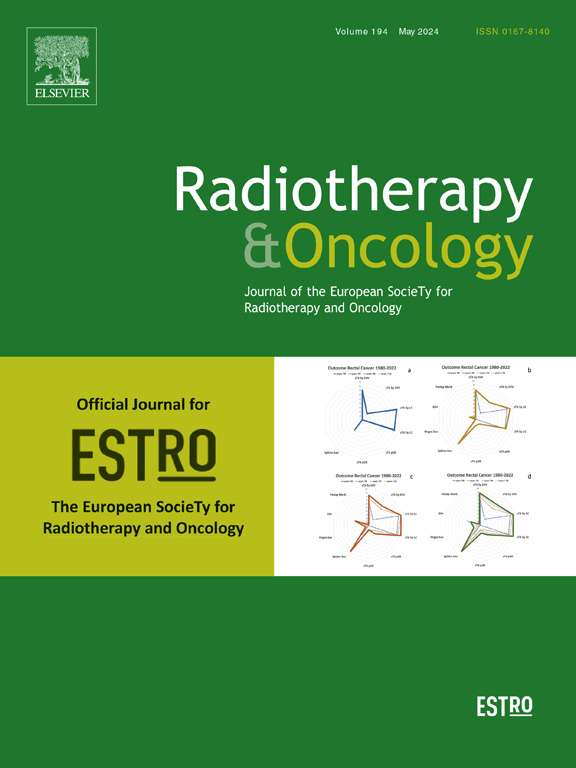Investigating the therapeutic potential of FLASH radiotherapy – a treatment planning study
IF 4.9
1区 医学
Q1 ONCOLOGY
引用次数: 0
Abstract
Purpose/Background
Ultra-high dose rate radiotherapy (RT) has shown potential for differential normal tissue (NT) sparing (a phenomenon termed the “FLASH effect”), particularly for larger fraction doses (>5 Gy). However, transitioning to hypofractionation may increase late-reacting NT toxicity, counteracting the FLASH effect. This study evaluates whether FLASH-RT can provide netsparing for organs at risk (OARs) and NT within the PTV under the assumption of standard-of-care dose-conformity.
Material/Methods
Five patients per tumor-site (breast, head-and-neck, prostate, and glioblastoma) were analyzed. Using the Linear-Quadratic model, dose-distributions with higher dose per fraction were derived from standard schedules while maintaining tumor control efficacy. FLASH-modified dose-distributions were simulated voxel-by-voxel using logistic regression-based dose-modifying factors modeled from preclinical data. These plans were converted to standard fractionation equivalents for radiobiological comparisons of NT damage. Netsparing was defined as the difference in OAR dose-volume histogram parameters between standard and FLASH-modified plans, normalized to the prescribed dose. Commonly used α/β-ratios for tumors and late-reacting NT were applied.
Results
The netsparing for OARs and PTV varied strongly by tumor location. Breast and prostate cases showed positive netsparing, indicating that the FLASH effect outweighed increased toxicity. Even under a conservative scenario (higher α/βT vs. α/βNT), most OARs showed positive netsparing. In glioblastoma and head-and-neck cases, no netsparing was observed, indicating increased toxicity even with FLASH induced NT-sparing.
Conclusion
FLASH-RT appears to be beneficial for tumor sites where α/βT ≲ α/βNT, such as breast and prostate. However, not all tumor sites may benefit from FLASH-RT, highlighting the need for site-specific consideration for FLASH-RT implementation.
研究FLASH放疗的治疗潜力-一项治疗计划研究。
目的/背景:超高剂量率放疗(RT)已显示出差异正常组织(NT)保留的潜力(一种称为“FLASH效应”的现象),特别是对于较大剂量(bbb50 Gy)。然而,过渡到低分馏可能会增加反应后期NT毒性,抵消FLASH效应。本研究评估了在标准治疗剂量一致性的假设下,FLASH-RT是否可以为PTV内的危险器官(OARs)和NT提供净保护。材料/方法:对每个肿瘤部位(乳腺、头颈部、前列腺和胶质母细胞瘤)的5例患者进行分析。使用线性-二次模型,在保持肿瘤控制功效的情况下,根据标准方案推导出较高剂量/分数的剂量分布。使用基于逻辑回归的剂量修饰因子,根据临床前数据建模,逐体素模拟flash修饰的剂量分布。这些图被转换成标准分馏当量,用于NT损伤的放射生物学比较。Netsparing定义为标准方案和flash修改方案之间的OAR剂量-体积直方图参数的差异,归一化为规定剂量。采用肿瘤和晚期反应NT常用的α/β比值。结果:OARs和PTV的网络保护因肿瘤位置的不同而有很大差异。乳腺和前列腺病例显示阳性净节约,表明FLASH的作用大于毒性增加。即使在保守的情况下(较高的α/βT vs α/βNT),大多数OARs也表现出正的净节约。在胶质母细胞瘤和头颈部病例中,未观察到netsparing,这表明即使使用FLASH诱导的NT-sparing,毒性也会增加。结论:对于α/βT > α/βNT的肿瘤部位,如乳腺和前列腺,FLASH-RT似乎是有益的。然而,并不是所有的肿瘤部位都能从FLASH-RT中获益,这就强调了在实施FLASH-RT时需要针对特定部位进行考虑。
本文章由计算机程序翻译,如有差异,请以英文原文为准。
求助全文
约1分钟内获得全文
求助全文
来源期刊

Radiotherapy and Oncology
医学-核医学
CiteScore
10.30
自引率
10.50%
发文量
2445
审稿时长
45 days
期刊介绍:
Radiotherapy and Oncology publishes papers describing original research as well as review articles. It covers areas of interest relating to radiation oncology. This includes: clinical radiotherapy, combined modality treatment, translational studies, epidemiological outcomes, imaging, dosimetry, and radiation therapy planning, experimental work in radiobiology, chemobiology, hyperthermia and tumour biology, as well as data science in radiation oncology and physics aspects relevant to oncology.Papers on more general aspects of interest to the radiation oncologist including chemotherapy, surgery and immunology are also published.
 求助内容:
求助内容: 应助结果提醒方式:
应助结果提醒方式:


